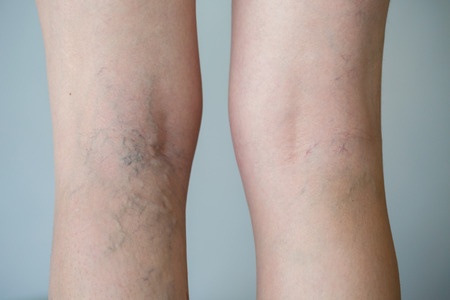 EverydayHealth.com recently ran an article about varicose veins and the most popular misconceptions about them.
EverydayHealth.com recently ran an article about varicose veins and the most popular misconceptions about them.
Fact: Varicose veins affect about 25% of U.S. adults.
Fact: About 22 million women and 11 million men between the ages of 40 and 80.
Fact: If you happen to have blue, bulging, visible blood vessels in your legs –– which are known as varicose veins — you should know that they’re a sign of venous insufficiency, also known as progressive vein disease. This is a medical condition, not a cosmetic issue, and could lead to blood clots or other medical concerns like bleeding, skin discoloration, skin thickening, and ankle/foot ankle ulcer formation.
Vein disease is caused by damaged vein valves that allow blood to flow backwards towards your feet instead of upwards towards your heart. If your veins have too much blood backing up, it can cause them to bulge, thicken, and become very embarrassing.
So to educate you on the some facts about enlarged, unsightly veins, Waterford Vein Institute of Hawaii is sharing these myths and facts that you should know.
Myth #1: Varicose veins are just a cosmetic issue
Not true. Vein disease is a progressive disease, so most patients with varicose veins will most likely develop more visible symptoms such as swollen, bulging veins, pain, throbbing, cramping, tired legs, heavy feeling legs, and restless legs at night.
Myth #2: Varicose veins are a sign of aging
Varicose veins get worse with age, though not everyone you know will get them and younger people in their teens and 20s can get them, too. The point is, if your parents have vein disease, or if you have changes in your hormone levels because of pregnancy, sorry to say you’ll probably get varicose veins, too.
Myth #3: Only women are affected by varicose veins
While approximately 25% of women are ultimately affected by varicose veins, men can get them, too. In fact, about 10 – 15% of men are affected, too, especially if you’ve played basketball, volleyball, or tennis, spending long hours on hard surfaces.
Myth #4: Varicose veins are caused by running
Exercises like running are typically good for your circulation and your veins because exercise pumps more blood to and from your heart. But some experts disagree whether exercising makes your veins better or worse. So if you’re a runner, try cooling off your legs when you finish and elevate your legs to help any pooling blood flow back uphill.
Myth #5: Varicose veins are visible at all times
Sometimes, you see them as ropey, bulging veins. Other times you don’t because they’re below the surface of your skin on your legs. Either way, you can still have varicose veins.
Myth #6: Standing all day causes varicose veins
Bartenders, waiters, teachers, flight attendants, policemen, and hairdressers are among the types of jobs where you spend long hours on your feet, day after day. If your legs ache, feel “heavy” or restless at night, you may have varicose veins. But prolonged standing may or may not cause the symptoms to occur for everyone.
Myth #7: Changing your lifestyle won’t help
Eating too much food and not exercising often enough can cause a weight problem, which is a scenario that often causes varicose veins. So your lifestyle does make a difference and changing your lifestyle can help prevent or lessen the effects of varicose veins.
Myth #8: Vein surgery is your only option
For decades, your only option was traditional vein stripping which involved a hospital stay, general anesthetic, a few days of recovery, and permanent scars. Now, quadruple board-certified Dr. Randy Waterford uses advanced, minimally invasive procedures such as Endovenous Laser Ablation, Radiofrequency Ablation, Injection Sclerotherapy, and Ultrasound Guided Sclerotherapy to quickly, effectively resolve varicose vein and spider vein issues.
Myth #9: Varicose vein treatment recovery is difficult
With these types of quick, in-office procedures, recovery is actually much quicker than you might expect. In most cases, patients have minimal to no downtime, are back on the feet in hours, and back at work or play by the next day.
Myth #10: Varicose veins cannot be cured
There is no cure for vein disease, but with effective treatments using the latest techniques, fewer procedures may be needed in the future. However, some people with venous insufficiency may have a repeat appearance of varicose veins months or years after a treatment.
For more information about varicose vein symptoms or treatments, contact Dr. Randy Waterford at Waterford Vein Institute of Hawaii at (808) 871-VEIN (8346).
